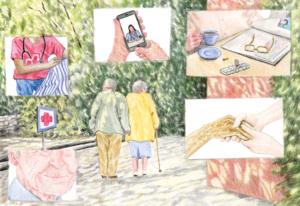
Illustration : Pau Gasol Valls
Description
The British Red Cross is currently in the Discovery phase with a goal “to engage and understand the strengths and needs of communities in high risk, low resource places”. The British Red Cross will then design and test new services with communities that will help the organisation to become more engaged and relevant at a local level. Additionally to be aware of and respond to changing needs of crises across the UK.
Context
Along with the development of society, local communities have changed and evolved an enormous amount over the last 150 years since the founding of the British Red Cross.
Many of its services date back more than 80 years and have not changed and modernised a huge amount over that period. Alongside this in 2016 the British Red Cross completed a 3 year programme of restructure, ‘Reshaping Our Work’ which brought clarity around service line divides and a national governance structure which was a necessary step in order to become more modern and efficient. This also allowed for users of services to receive the same service in London as they would in Belfast, and internal accountability for each area and service line of the organisation.
As part of its ‘Strategy 2030’ the British Red Cross retains 3 key areas of causal focus as it navigates the next 10 years: displacement and migration, health inequalities and disasters and emergencies (fire and flooding.) Although the number of people suffering crises following fires and flooding has continued to decrease, with improvements in technology and preventative measures, this still remains an issue thousands of UK residents have to contend with every year. There is a continuing increase in those wishing to enter the country and those suffering from ever increasingly unequitable access to healthcare.
An unexpected and unwanted consequence of all of these things is that the British Red Cross seems to be more disconnected from local communities (than ever before.) Not offering what is necessarily most needed by the users it is here to support, and even when possessing the right skills and resources is not always connected enough with the local communities, after the nationalising of services and a huge exodus of old staff/volunteers leading to loss of local relationships.
Technical details & Operations
In response to a weakening of its presence locally, providing relevant services, and in order to help the British Red Cross become a more community led organisation and have more active citizen participation the British Red Cross is exploring a community based approach.
This discovery aim was to ‘engage and understand the strength and needs of communities in high risk, low resource places.’ This work has been progressed after a 2 year engagement by multiple members of the British Red Cross innovation team with individual’s from the French Red Cross’ ‘Third Places’ team, further research and a desire to ensure the organisation retains relevant and ‘plugged in’ to local communities having acknowledged this has become a more pressing question.
The ‘Third Places’ spaces of the French Red Cross also look to remedy some of the biggest problems outside of our 3 causal priorities that the British Red Cross know affect its communities, things such as using technology and digital access, to information, supporting people currently unemployed and housing advice. With ever increasing numbers of people affected by these issues in the UK, and our early insights highlighting clearly that our 3 pilot locations have large problems with health inequalities, homelessness and the digital divide the work already undertaken provides great insight as the association move forward with the discovery. The British Red Cross is also acutely aware of the ongoing problems people are facing emanating from isolation and loneliness, with several products and services already actively engaging users to resolve these issues. These spaces provide a great environment and opportunity to connect people with other individuals in their community, while accessing other services.
Deployment & Impact
To explore these issues the British Red Cross began a ‘big bet’ in August 2020 to be led by the Central Innovation Hub across 3 pilot locations, with specific community make ups and characteristics defining the location of these pilots:
- Camborne, Cornwall, England
Criteria: Selected due to the high levels of health inequalities and communities at risk of flooding, medium size population and good British Red Cross presence in the area currently.
- Neath, Neath Port Talbot, Wales
Criteria: Selected due to high levels of health inequalities and communities at risk of flooding, medium to large population and a reasonable British Red Cross presence in the area currently.
- Nelson, Lancashire, England
Criteria: Selected due to communities at risk of flooding and communities affected by migration and displacements, medium to small population and very little British Red Cross presence in the area.
This work is being led by the communities of the British Red Cross to ensure that it addresses and reflects the true strengths and needs locally. Research techniques include Community activity packs to be posted to research participants (cultural probes), Semi structured interviews via zoom or phone, and group community forums (similar to Citizen assemblies). All research has been carried out in a ‘lockdown’ environment due to Covid-19.





